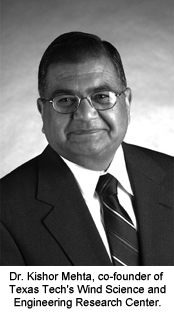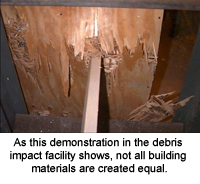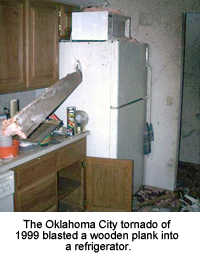Texas Tech University
Texas Tech Turns Tornado Tragedy to Triumph
 Thirty-five years after one of the costliest tornadoes in U.S. history killed 26 people in this West Texas city, researchers at Texas Tech University have established one of the nation's foremost centers for the study of wind damage and mitigation.
Thirty-five years after one of the costliest tornadoes in U.S. history killed 26 people in this West Texas city, researchers at Texas Tech University have established one of the nation's foremost centers for the study of wind damage and mitigation.
 The Wind Science and Engineering Research Center was founded after the Lubbock tornado of May 11, 1970, which did more than $100 million in damage, and Hurricane Celia, which devastated Corpus Christi later that year. Kishor Mehta, Horn professor of civil engineering and former director of the center, said that a group of Texas Tech professors were motivated by the disasters to form the center, which was originally called the Institute for Disaster Research.
The Wind Science and Engineering Research Center was founded after the Lubbock tornado of May 11, 1970, which did more than $100 million in damage, and Hurricane Celia, which devastated Corpus Christi later that year. Kishor Mehta, Horn professor of civil engineering and former director of the center, said that a group of Texas Tech professors were motivated by the disasters to form the center, which was originally called the Institute for Disaster Research.
 "No one studied things like this at the time," Mehta said. "We looked around us and realized we were in the perfect place to learn more about how wind damages buildings and how to prevent it. It was an opportunity to take a tragedy and turn it into a way to make concrete, positive change in people's lives."
"No one studied things like this at the time," Mehta said. "We looked around us and realized we were in the perfect place to learn more about how wind damages buildings and how to prevent it. It was an opportunity to take a tragedy and turn it into a way to make concrete, positive change in people's lives."
In the 35 years since the center's founding, it has grown from five to 21 faculty members, a staff of 13 and about 45 students, all of whom have helped the center make significant advances in wind engineering research. They have pioneered the design of in-home tornado shelters, established field laboratories to study wind effects, guided the development of national standards to help buildings withstand high winds, created the tornado hazard model for the nuclear industry and developed and tested storm-resistant shelters and glass.
 "We've had a significant influence nationwide," said Andrew Swift, the center's current director. "The work of this center helped set the standards for the building industry in regard to reducing the impact of damaging winds, and the entire concept of a tornado or extreme wind shelter, along with the resulting National Storm Shelter Association, was initiated because of the work of the people in this center."
"We've had a significant influence nationwide," said Andrew Swift, the center's current director. "The work of this center helped set the standards for the building industry in regard to reducing the impact of damaging winds, and the entire concept of a tornado or extreme wind shelter, along with the resulting National Storm Shelter Association, was initiated because of the work of the people in this center."
Mehta said the center's resources, including a compressed-air cannon that launches high-speed projectiles to test the durability of shelter walls and glass, have helped Texas Tech achieve success.
Swift said the center plans to expand its focus in the coming years to examine the possibilities of wind energy.
"The focus will be on wind characterizations and risk mitigation, as more wind power plants are deployed throughout the state and region," Swift said. "We are also looking at opportunities for wind power to move and purify water to address the region's critical water needs."
